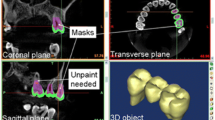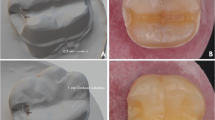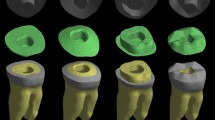Abstract
This study determines the RBFPD (resin-bonded fixed partial dentures) biomechanical aspects to retainer height using structural-thermal coupled finite element (FE) analysis under normal (37°C) and high (51°C) oral temperatures. Three RBFPD FE models with different retainer heights (100, 75, and 50% of the distance from 2 mm above the CE (cementum-enamel) junction to the occlusal surface) were created using image processing, contour stacking, and mapping mesh procedures. After FE model validation, the maximum first principal and von Mises stresses in the remaining tooth (σT) and prosthesis (σP), were recorded for all models under structural-thermal coupled analyses. The simulation results showed that the σT and σp values decreased with greater retainer height as a result of the increasing prosthesis stiffness and maximizing bonding area between the enamel and retainer at normal oral temperature (37°C). However, no significant stress differences were found according to the retainer height varying dimensions at high (51°C) temperatures. The RBFPD retainer height biomechanical response is dominated by the structural analysis result (at 37°C) and it is recommended that the prosthesis retainer have as great a height as possible to decrease the stress values.




Similar content being viewed by others
References
Benzing UR, Gall H, Weber H (1995) Biomechanical aspects of two different implant- prosthetic concepts for edentulous maxillae. Int J Oral Maxillofac Implant 10:188–198
Boccaccio A, Prendergast PJ, Pappalettere C, Kelly DJ (2008) Tissue differentiation and bone regeneration in an osteotomized mandible: a computational analysis of the latency period. Med Biol Eng Comput 46:283–298
Botelho M (1999) Resin-bonded prostheses: the current state of development. Quintessence Int 30:525–534
Caputo AA, Standlee JP (1987) Biomechanics in clinical dentistry. Quintessence Publishing, Chicago, pp 123–149
Chang YH, Lin WH, Kuo WC, Chang CY, Lin CL (2009) Mechanical interactions of cuspal-coverage designs and cement thickness in a cusp-replacing ceramic premolar restoration: a finite element study. Med Biol Eng Comput 47:367–374
Creugers NH, Kayser AF (1992) An analysis of multiple failures of resin-bonded bridges. J Dent 20:348–351
Dimashjieh MR, Al-Shammery AR (2000) Long-term survival of sleeve-designed fixed partial dentures: a clinical report. J Prosthet Dent 84:591–593
El-Mowafy O, Rubo MHM (2000) Retention of a posterior resin-bonded fixed partial denture with a modified design: an in vitro study. Int J Prosthodont 13:425–431
Eshleman JR, Janus CE, Jones CR (1988) Tooth preparation designs for resin-bonded fixed partial dentures related to enamel thickness. J Prosthet Dent 60:18–22
Farah JW, Craig RG, Meroueh KA (1989) Finite element analysis of three- and four-unit bridges. J Oral Rehabil 16:603–611
Fenner DN, Robinson PB, Cheung PMY (1998) Three-dimensional finite element analysis of thermal shock in a premolar with a composite resin MOD restoration. Med Eng Phys 20:269–275
Gale MS, Darvell BW (1999) Thermal cycling procedures for laboratory testing of dental restorations. J Dent 27:89–99
Goel VK, Khera SC, Gurusami S, Chen RC (1992) Effect of cavity depth on stresses in a restored tooth. J Prosthet Dent 67:174–183
Lin CL, Chang CH, Cheng CS, Lee HE (1999) Three dimensional finite element meshing generation for maxillary second premolar. Comput Methods Programs Biomed 59:187–195
Lin CL, Lin TS, Hsu KW, Wu CH, Chang CH (2003) Numerical investigation of retainer thickness affecting retention in posterior resin-bonded prosthesis using the finite element method. J Chin Inst Eng 6:781–789
Lin CL, Hsu KW, Wu CH (2005) Multi-factorial retainer design analysis of posterior resin-bonded fixed partial dentures: a finite element study. J Dent 33:711–720
Lin CL, Chang YH, Lin YF (2008) Combining structural-thermal coupled field FE analysis and the Taguchi method to evaluate the relative contributions of multi-factors in a premolar adhesive MOD restoration. J Dent 36:626–636
Morris HF (1989) Veterans Administration Cooperative Studies Project No. 147/242, part VII: the mechanical properties of metal ceramic alloys as cast and after simulated porcelain firing. J Prosthet Dent 61:160–169
Priest G (1995) An eleven-year reevaluation of resin-bonded fixed partial dentures. Int J Periodont Restor Dent 15:239–247
Provatidis CG (2000) A comparative FEM—study of tooth mobility using isotropic and anisotropic models of the periodontal ligament Finite Element Method. Med Eng Phys 22:359–370
Rochette AL (1973) Attachment of a splint to enamel of lower anterior teeth. J Prosthet Dent 30:418–423
Sato Y, Yuasa Y, Abe Y, Akagawa Y (1995) Finite element and Weibull analysis to estimate failure risk in resin-bonded retainers. Int J Prosthodont 8:73–78
Toms SR, Dakin GJ, Lemons JE, Eberhardt AW (2002) Quasi-linear viscoelastic behavior of the human periodontal ligament. J Biomech 35:1411–1415
Toparli M, Aykul H, Sasaki S (2003) Temperature and thermal stress analysis of a crowned maxillary second premolar tooth using three-dimensional finite element method. J Oral Rehabil 30:99–105
Yang HS, Lang LA, Guckes AD, Felton DA (2001) The effect of thermal change on various dowel-and-core restorative materials. J Prosthet Dent 86:74–80
Yoshida N, Koga Y, Peng CL, Tanaka E, Kobayashi K (2001) In vivo measurement of the elastic modulus of the human periodontal ligament. Med Eng Phys 23:567–572
Author information
Authors and Affiliations
Corresponding author
Rights and permissions
About this article
Cite this article
Chang, WJ., Lin, CL. Estimation of the retainer height biomechanical contribution in posterior resin-bonded fixed partial dentures: a structural-thermal coupled finite element analysis. Med Biol Eng Comput 48, 1115–1122 (2010). https://doi.org/10.1007/s11517-010-0666-2
Received:
Accepted:
Published:
Issue Date:
DOI: https://doi.org/10.1007/s11517-010-0666-2




